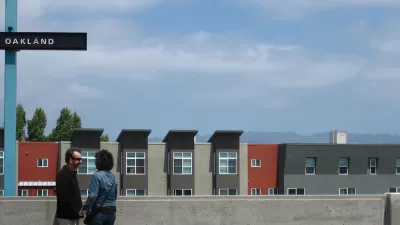As Sen. Wiener has announced new amendments to the controversial land use, transit-oriented development, and real estate bill, The Planning Report turns to three experts to unpack the legislation's consequences.

Despite its stated goals of promoting transit-oriented development and improving affordability through dense new housing supply, nearly every housing justice organization in California has vehemently opposed SB 827. In a series of interviews, The Planning Report aimed to drill down on the potential impacts of the bill, and depoliticize the contentious policy conversation.
In an interview with Michael Storper—accomplished economic geographer, director of UCLA Luskin’s Global Public Affairs program, and one of the most cited social scientists in the world—Storper was critical of the turn in the urban planning field toward simplistic, Laffer-esque supply-side economics.
Critiquing the "one-size-fits-all" priorities of today’s transit-oriented development urbanism, Storper cast doubt on the notion that merely adding density—unaccompanied by targeted policies to prevent displacement—will benefit the majority of urban residents stressed by unaffordable cost and access to the coastal housing market. Storper, who authored The Rise and Fall of Urban Economies to address the differences in economies like San Francisco and Los Angeles, provided context to the demographic breakdown of Los Angeles and the lack of impact most low and middle-income earners will feel from upzoning transit corridors. On SB 827, Storper stated that it is "naïve to think that this approach will help the bottom 60 percent of wage earners in an area like Southern California. It’s worth pointing out that some of the areas that will gain density will already be expensive—areas where land prices are already high—and some will be newly gentrifying areas."
However, Storper was not completely critical of the intentions of SB 827 and the overall intentions of Sen. Scott Wiener to address the state's housing problem through transit-oriented development. Ultimately, Storper was critical of the fact that SB 827's language is "a very blunt instrument," that would result in "all kinds of contradictory effects" in California.
TPR also turned to two experts on transit and equitable development: Denny Zane, leading transit advocate, former mayor of Santa Monica, and executive director of Move LA; and Cynthia Strathmann, executive director of Strategic Actions for a Just Economy (SAJE), a long-standing non-profit for equitable development and tenant rights in South Los Angeles.
Strathmann, echoing Storper's criticism of SB 827 for its lack of inclusiveness in the bill, noted that "the danger with SB 827 is that there is no mandatory affordability or preservation component." Upzoning transit-rich corridors without inclusionary components could lead to high-end luxury construction, which would exacerbate displacement pressures for low-income residents who are the actual users of transit. The increase in housing supply would not produce any housing that would actually make low-income residents more housing-secure. Strathmann also voiced concerns that SB 827 could really undermine the efforts that came to fruition with the People’s Plan for South LA, a long-term anti-displacement plan to growth South LA while uplifting lower-income communities of color.
"Some people believe that more density, in and of itself, will give us the benefits we need. They tend to advocate broad authorization of density, especially near transit corridors. I’m not convinced of that approach. I think that more housing density alone can actually have contradictory effects on cities. It affects where people live within the metro area; it affects who lives in the new housing; it affects how the metro area grows as a whole—that is, how much population growth it gets; and it affects affordability and inclusion. It’s like a four-dimensional puzzle—putting all those pieces together, you can get a lot of different answers."

Maui's Vacation Rental Debate Turns Ugly
Verbal attacks, misinformation campaigns and fistfights plague a high-stakes debate to convert thousands of vacation rentals into long-term housing.

Planetizen Federal Action Tracker
A weekly monitor of how Trump’s orders and actions are impacting planners and planning in America.

Chicago’s Ghost Rails
Just beneath the surface of the modern city lie the remnants of its expansive early 20th-century streetcar system.

Bend, Oregon Zoning Reforms Prioritize Small-Scale Housing
The city altered its zoning code to allow multi-family housing and eliminated parking mandates citywide.

Amtrak Cutting Jobs, Funding to High-Speed Rail
The agency plans to cut 10 percent of its workforce and has confirmed it will not fund new high-speed rail projects.

LA Denies Basic Services to Unhoused Residents
The city has repeatedly failed to respond to requests for trash pickup at encampment sites, and eliminated a program that provided mobile showers and toilets.
Urban Design for Planners 1: Software Tools
This six-course series explores essential urban design concepts using open source software and equips planners with the tools they need to participate fully in the urban design process.
Planning for Universal Design
Learn the tools for implementing Universal Design in planning regulations.
planning NEXT
Appalachian Highlands Housing Partners
Mpact (founded as Rail~Volution)
City of Camden Redevelopment Agency
City of Astoria
City of Portland
City of Laramie





























